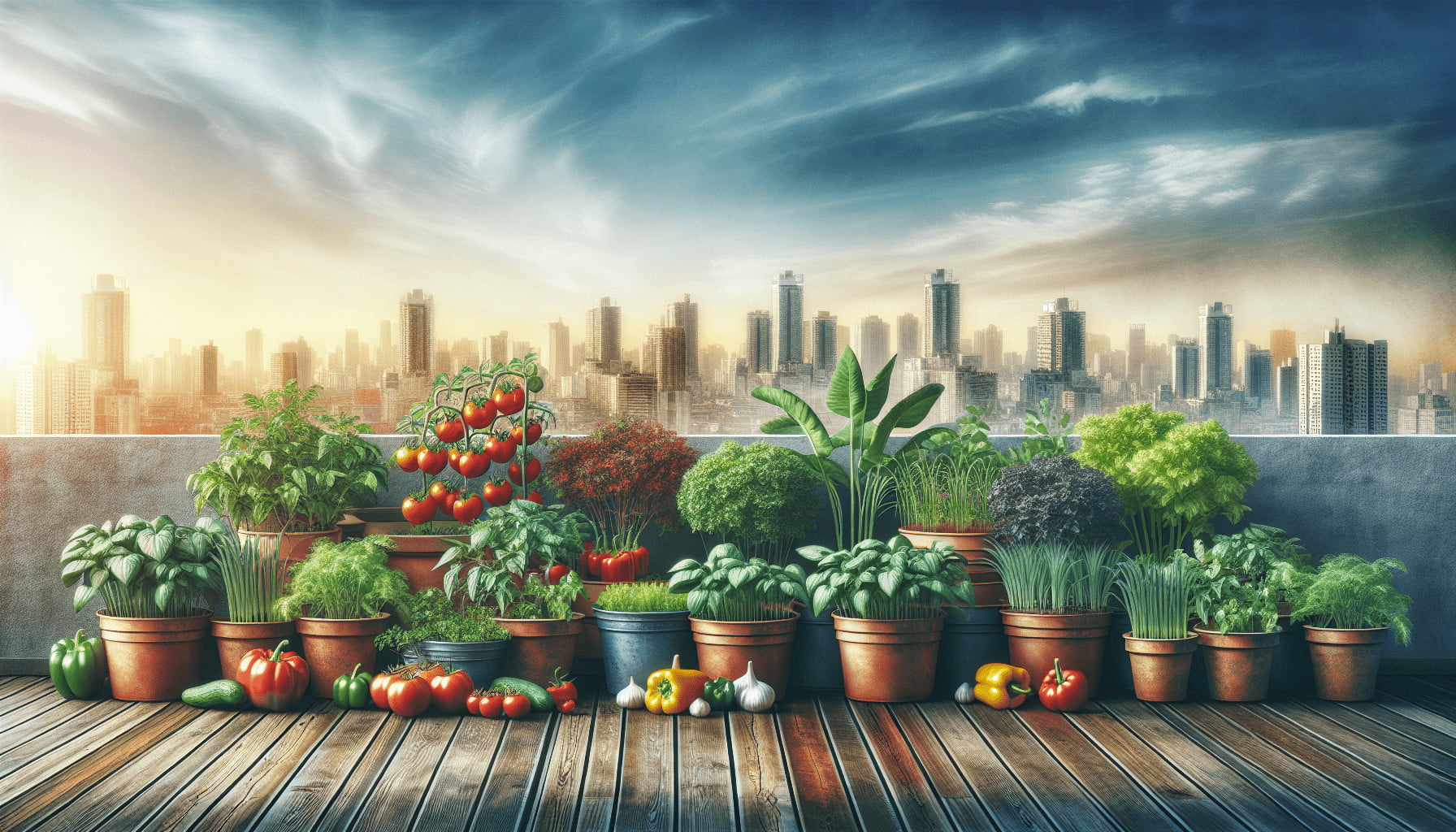Have you ever thought about transforming your underutilized rooftop into a vibrant garden filled with fresh vegetables? Growing vegetables in rooftop containers offers a unique gardening experience that’s both rewarding and sustainable. Whether you’re limited by space or just looking to enhance your urban living conditions, rooftop gardening is an excellent way to grow your greens and make the most of your available space. Let’s dive into this friendly guide to help you get started on your journey to growing vegetables in rooftop containers.
Understanding Rooftop Container Gardening
Rooftop container gardening is exactly what it sounds like—growing plants in containers located on your rooftop. This type of gardening is particularly beneficial for those living in urban environments or areas lacking backyards. The best part? You have full control over the soil quality, watering schedules, and even the microclimate specific to your rooftop.
Why Choose Rooftop Container Gardening?
There are numerous reasons to consider rooftop container gardening. Not only does it allow you to grow your fresh produce, but it also has environmental benefits. Container gardening reduces the heat island effect common in urban settings and can help insulate your home. Additionally, gardening provides a therapeutic hobby that can improve your mental well-being.
Basic Requirements: What You Need to Get Started
Before you start planting, it’s essential to consider a few initial requirements:
- Structural Integrity: Make sure your rooftop can handle the weight of containers filled with soil and water.
- Sunlight Exposure: Most vegetables need at least 6-8 hours of direct sunlight.
- Water Supply: Ensure easy access to water for consistent and convenient watering.
Choosing the Right Containers
Selecting the right containers is crucial for the success of your rooftop garden. The type and size of containers you need will largely depend on the vegetables you’re planning to grow.
Types of Containers
Here are some common types of containers to consider:
| Type | Material | Benefits |
|---|---|---|
| Clay Pots | Clay | Natural look, allows root aeration |
| Plastic Pots | Plastic | Lightweight, often inexpensive |
| Fabric Grow Bags | Fabric | Excellent air circulation, prevents overwatering |
| Wooden Planters | Wood | Aesthetic appeal, provides insulation |
| Self-watering Pots | Various | Maintains consistent moisture levels |
Each type of container has its benefits and drawbacks, so consider what will work best for your needs and budget.
Container Size and Depth
Different vegetables have varying root depth requirements. Here’s a simple guide to help you choose the right container size:
| Vegetable | Minimum Depth Required |
|---|---|
| Leafy Greens | 6-8 inches |
| Root Vegetables | 12-18 inches |
| Tomatoes/Peppers | 18-24 inches |
| Vine Crops | 24 inches and up |
Make sure the containers have adequate drainage holes to prevent waterlogging, which can lead to root rot.

Selecting the Best Soil Mix
The right soil mix can make or break your rooftop garden. Unlike traditional garden soil, containerized soil needs to be well-draining yet moisture-retentive.
Ideal Soil Composition
A high-quality potting mix should include the following components:
- Peat Moss or Coconut Coir: For lightweight water retention.
- Perlite or Vermiculite: Enhances drainage and aeration.
- Compost: Provides essential nutrients for healthy plant growth.
Here’s a basic recipe for a balanced potting mix:
| Ingredient | Quantity |
|---|---|
| Peat Moss | 40% |
| Compost | 40% |
| Perlite/Vermiculite | 20% |
You can also add slow-release fertilizers or organic amendments like worm castings to improve nutrient availability.
Preparing Your Containers
Once you have your soil mix, it’s time to fill your containers. Ensure that you layer the bottom with small stones or shards of broken pots to aid drainage. Fill your containers, leaving about an inch from the rim to prevent overflow during watering.
Choosing the Right Vegetables
Not all vegetables are suited for container gardening, especially on a rooftop where conditions can be harsh. Here’s a list of vegetables that are generally successful when grown in containers:
| Vegetables | Notes |
|---|---|
| Tomatoes | Requires staking or cages |
| Peppers | Needs support as they grow |
| Leafy Greens (spinach, kale) | Grows well in shallow pots |
| Root Vegetables (carrots, radishes) | Deep containers needed |
| Herbs (basil, parsley) | Excellent for small spaces |
| Cucumbers | Vining variety needs trellis |
By choosing the right vegetables, you can ensure a bountiful and satisfying harvest.

Planting Your Vegetables
Once you have your containers, soil, and chosen vegetables, it’s time to plant.
Sowing Seeds vs. Transplants
Decide whether you want to start from seeds or transplants. Seeds are economical but take longer to grow. Transplants (seedlings) have a head start but are costlier.
Steps for Planting
- Prepare the Soil: Make sure your potting mix is loose and well-moistened.
- Planting Depth: Plant seeds or transplants at the depth recommended on the seed packet or plant label.
- Spacing: Follow spacing guidelines to prevent overcrowding and ensure adequate airflow.
- Watering: Water thoroughly after planting to settle the soil and initiate root growth.
Initial Care
The first few weeks are crucial for plant establishment. Keep the soil moist but not waterlogged. You can use a moisture meter to check soil moisture levels accurately.
Maintenance: Keeping Your Rooftop Garden Healthy
Regular maintenance is key to keeping your rooftop garden lush and productive.
Watering
Vegetables in containers dry out faster than those in the ground, especially exposed to wind and sun. Water your plants early in the morning or late in the afternoon to minimize evaporation. Self-watering containers can be a great investment to help maintain consistent moisture levels.
Fertilizing
Container-grown vegetables deplete nutrients faster than in-ground plants. Use a balanced, water-soluble fertilizer every 2-4 weeks, or add slow-release fertilizer to your potting mix. Organic options like compost tea or fish emulsion can also provide a nutrient boost.
Pruning and Staking
Some vegetables, like tomatoes and peppers, will need support as they grow. Staking, trellising, or using cages can help keep plants upright and ensure they get adequate sunlight. Regular pruning of dead or diseased leaves also encourages healthy growth.
Pest and Disease Management
Rooftop gardens are not immune to pests and diseases. Keep an eye out for common signs of trouble like yellowing leaves, holes, or stunted growth.
Common Pests
Here are some pests you might encounter and how to deal with them:
| Pest | Symptoms | Control Methods |
|---|---|---|
| Aphids | Sticky leaves, leaf curling | Insecticidal soap, ladybugs |
| Spider Mites | Webbing, speckled yellow leaves | Neem oil, miticide |
| Whiteflies | White, powdery clusters on leaves | Sticky traps, insecticidal soap |
Common Diseases
Diseases can also affect your rooftop vegetables:
| Disease | Symptoms | Control Methods |
|---|---|---|
| Powdery Mildew | White, powdery spots on leaves | Remove affected leaves, fungicide |
| Root Rot | Wilting, brown roots | Ensure proper drainage, avoid overwatering |
| Blight | Black or brown spots on leaves | Prune diseased foliage, increase airflow |
Early detection and intervention are critical for managing pests and diseases effectively.
Harvesting Your Vegetables
The reward of all your hard work is a delicious, fresh harvest. Harvest times vary depending on the vegetable, so refer to your seed packets or plant labels for specific timelines.
General Harvest Tips
- Harvest Early: Vegetables like leafy greens and herbs are often best when young and tender.
- Regular Picking: For plants like beans or tomatoes, regular picking encourages more production.
- Use Pruning Shears: Use clean, sharp tools to harvest to prevent plant damage and disease spread.
Seasonal Tips for Rooftop Gardening
Your rooftop garden will change with the seasons, and so should your approach to gardening.
Spring
Spring is the ideal time to start planting most vegetables. Ensure your containers are prepped and ready to go as soon as the last frost date has passed.
Summer
Summer can be harsh, especially on rooftops. Shade cloths and mulching can help protect your plants from extreme heat and conserve soil moisture.
Fall
In the fall, focus on planting cool-weather crops like kale, spinach, and carrots. This is also a good time to clean and prepare your containers for the winter months.
Winter
If you live in a mild climate, winter gardening is still possible with the right crops. Otherwise, use this time to plan for the next growing season and maintain any perennial plants.
Sustainable Gardening Practices
Sustainability is key to maintaining a healthy, vibrant garden. Here are some tips to make your rooftop garden more eco-friendly:
Rainwater Harvesting
Collecting rainwater can significantly reduce your water usage. Set up barrels to capture runoff and use it for watering your rooftop garden.
Composting
Create a small compost setup to recycle kitchen scraps and garden waste. This organic matter can enrich your soil naturally.
Natural Pest Control
Use natural pest control methods like companion planting or introducing beneficial insects to reduce the need for chemical interventions.
Conclusion
Embarking on the journey of growing vegetables in rooftop containers can be incredibly rewarding. With the right preparation and care, your rooftop can become a bountiful oasis, providing fresh, healthy produce while contributing to a greener urban environment.
So, ready to roll up your sleeves and start your rooftop vegetable garden? The fresh vegetables and the joy of nurturing plants await you! Enjoy every step of this fulfilling gardening adventure.
